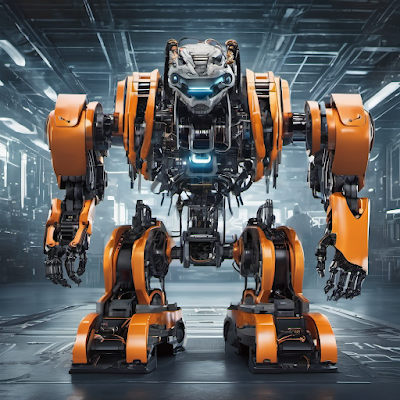Welcome to the thrilling realm where technology meets innovation, and the future is unleashed through the fascinating world of robotics. From the dawn of rudimentary automata to the advanced, intelligent machines of today, the journey of robotics in technology has been nothing short of extraordinary.
Historical Perspective
Early Robotics Achievements
The roots of robotics can be traced back to ancient civilizations with automated mechanisms designed for various purposes. Fast forward to the industrial revolution, and we witnessed the birth of the first true robots designed for manufacturing tasks.
Milestones in Robotic Technology
The 20th century brought monumental achievements, including the advent of programmable robots and the introduction of robotic arms in assembly lines. These milestones laid the groundwork for the sophisticated robots we see today.
Current State of Robotics
Robotics in Industries
Industries are embracing robotics for precision tasks, increasing efficiency, and ensuring workplace safety. Robots are now an integral part of manufacturing, automating repetitive processes and contributing to higher production rates.
Robotics in Daily Life
From vacuum-cleaning robots to voice-activated assistants, robotics has seamlessly integrated into our daily lives. Smart homes leverage robotic technology to enhance convenience, security, and energy efficiency.
Technological Advancements
Artificial Intelligence Integration
The marriage of robotics and artificial intelligence has propelled machines to new heights. Robots can now learn and adapt, making them more versatile and capable of handling complex tasks with minimal human intervention.
Machine Learning in Robotics
Machine learning algorithms empower robots to analyze data, make decisions, and improve performance over time. This continuous learning process enhances their ability to navigate dynamic environments and solve intricate problems.
Robotics and Automation
Impact on Labor Market
While automation streamlines processes, concerns about job displacement arise. However, the collaboration between humans and robots is reshaping the workforce, creating new opportunities and demanding a shift in skill sets.
Efficiency in Production
Robotics has revolutionized production lines by ensuring precision, speed, and consistency. This not only reduces costs but also elevates the overall quality of products, meeting the demands of an ever-evolving market.
Challenges Faced by Robotics
Ethical Concerns
As robots become more autonomous, ethical considerations emerge. Questions about responsibility, accountability, and decision-making in critical situations need thoughtful exploration.
Security and Privacy Issues
The interconnected nature of robotic systems raises concerns about data security and personal privacy. Safeguarding against cyber threats becomes paramount as these machines become integral to our daily lives.
Future Trends in Robotics
Humanoid Robots
Advancements in robotics are steering us towards the development of humanoid robots, mimicking human functions. These robots hold promise in various fields, from healthcare to customer service.
Medical Robotics
Robotics is making significant strides in the medical field, from surgical robots enhancing precision in operations to robotic exoskeletons aiding rehabilitation.
Robotic AI Assistants
The future envisions robotic AI assistants seamlessly integrating into our lives, simplifying tasks, providing information, and enhancing overall efficiency.
Robotics in Space Exploration
Robotic Missions to Other Planets
Robots play a crucial role in space exploration, conducting missions to distant planets, gathering data, and paving the way for potential human exploration.
Satellite Maintenance
In Earth's orbit, robotic systems are increasingly used for satellite maintenance, extending the lifespan of crucial communication and observation satellites.
Social and Economic Implications
Job Creation
While some jobs may be automated, the rise of robotics creates a demand for skilled professionals in robot design, maintenance, and programming, leading to job creation in new and exciting fields.
Economic Growth
The integration of robotics drives economic growth by fostering innovation, increasing productivity, and creating opportunities for businesses to thrive in a competitive landscape.
Environmental Impact of Robotics
Sustainable Robotics
Developments in sustainable robotics aim to minimize environmental impact. Energy-efficient designs and eco-friendly materials contribute to the creation of environmentally responsible robotic solutions.
Reduction of Environmental Footprint
By optimizing processes and reducing waste, robotics contributes to a more sustainable future, aligning technological progress with environmental stewardship.
Collaboration Between Humans and Robots
Coexistence in Workplaces
The future workplace envisions humans and robots working side by side, with each contributing unique strengths. Collaboration fosters innovation and efficiency.
Human-Robot Partnerships
Robotic systems are designed to complement human abilities, creating partnerships that enhance overall productivity and performance.
Education and Training in Robotics
Shaping the Workforce of the Future
Educational initiatives focusing on STEM (Science, Technology, Engineering, and Mathematics) are crucial for preparing the next generation for a workforce dominated by robotics and automation.
Importance of STEM Education
Nurturing a workforce with strong STEM foundations ensures a pool of talent capable of driving innovation in the rapidly evolving field of robotics.
Public Perception of Robotics
Influences from Popular Culture
Media portrayals of robots, from helpful companions to potential threats, shape public perception. Balancing these narratives is essential for fostering a realistic understanding of robotics.
Acceptance and Fear
As robots become more prevalent, society grapples with a mixture of acceptance and fear. Open dialogue and education are vital to addressing concerns and fostering widespread acceptance.
Regulations in Robotics
Ensuring Ethical Practices
As robotics advances, establishing ethical guidelines becomes imperative to prevent misuse and ensure responsible development and deployment of robotic systems.
Legal Frameworks
Regulatory frameworks must adapt to the evolving landscape of robotics, addressing issues such as liability, accountability, and safety standards.
Conclusion
In conclusion, the future is truly unleashed with robotics at the forefront of technological evolution. From enhancing daily life to propelling humanity into space, the possibilities are boundless. Embracing this future requires a balance of innovation, ethical considerations, and collaboration to harness the full potential of robotics.
5 Unique FAQs
Are robots going to take over all human jobs?
- While some jobs may be automated, the collaboration between humans and robots is reshaping the workforce, creating new job opportunities and demanding a shift in skill sets.
How do robotics and AI work together?
- The integration of artificial intelligence empowers robots to learn, adapt, and handle complex tasks, making them more versatile and capable.
What is the environmental impact of robotics?
- Sustainable robotics initiatives focus on energy-efficient designs and eco-friendly materials, contributing to a more environmentally responsible approach to technology.
How can society address ethical concerns in robotics?
- Open dialogue, education, and the establishment of ethical guidelines are essential to address concerns and ensure the responsible development and deployment of robotic systems.
What role does robotics play in space exploration?
- Robotics plays a crucial role in space exploration through missions to other planets, satellite maintenance, and gathering valuable data to pave the way for human exploration.


Comments
Post a Comment